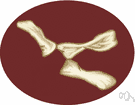pelvis
(redirected from gynecoid pelvis)Also found in: Thesaurus, Medical, Encyclopedia.
pelvis
anterior view of an adult male human pelvis
A. ilium
B. sacrum
C. acetabulum
D. pubis
E. pubic symphysis
F. ischium
pel·vis
(pĕl′vĭs)n. pl. pel·vis·es or pel·ves (-vēz)
1. A basin-shaped structure of the skeleton of many vertebrates, composed in humans of the hipbones on the sides, the pubis in front, and the sacrum and coccyx behind, that rests on the lower limbs and supports the spinal column.
2. The cavity formed by this structure.
3. See renal pelvis.
[Latin pēlvis, basin.]
American Heritage® Dictionary of the English Language, Fifth Edition. Copyright © 2016 by Houghton Mifflin Harcourt Publishing Company. Published by Houghton Mifflin Harcourt Publishing Company. All rights reserved.
pelvis
(ˈpɛlvɪs)n, pl -vises or -ves (-viːz)
1. (Anatomy) the large funnel-shaped structure at the lower end of the trunk of most vertebrates: in man it is formed by the hipbones and sacrum
2. (Anatomy) the bones that form this structure
3. (Anatomy) any anatomical cavity or structure shaped like a funnel or cup
4. (Anatomy) short for renal pelvis
[C17: from Latin: basin, laver]
Collins English Dictionary – Complete and Unabridged, 12th Edition 2014 © HarperCollins Publishers 1991, 1994, 1998, 2000, 2003, 2006, 2007, 2009, 2011, 2014
pel•vis
(ˈpɛl vɪs)n., pl. -vis•es, -ves (-viz)
1.
a. the basinlike cavity in the lower trunk of the body, formed by the sacrum, ilium, ischium, and pubis.
b. the bones forming this cavity.
2. the cavity of the kidney that receives the urine before it is passed into the ureter.
[1605–15; < New Latin; Latin: basin; akin to Greek pellís bowl]
pel′vic, adj.
Random House Kernerman Webster's College Dictionary, © 2010 K Dictionaries Ltd. Copyright 2005, 1997, 1991 by Random House, Inc. All rights reserved.
pel·vis
(pĕl′vĭs) The basin-shaped structure in vertebrate animals that joins the spine and lower or hind limbs. In primates, the pelvis is composed of the two hipbones joined to the sacrum. It contains and supports the intestines, bladder, and internal reproductive organs.
The American Heritage® Student Science Dictionary, Second Edition. Copyright © 2014 by Houghton Mifflin Harcourt Publishing Company. Published by Houghton Mifflin Harcourt Publishing Company. All rights reserved.
pelvis
A bony basin formed by the two hip bones, the sacrum, and the coccyx; also the core of a kidney, containing the broad upper end of a ureter.
Dictionary of Unfamiliar Words by Diagram Group Copyright © 2008 by Diagram Visual Information Limited
ThesaurusAntonymsRelated WordsSynonymsLegend:
Switch to new thesaurus
| Noun | 1. |  pelvis - the structure of the vertebrate skeleton supporting the lower limbs in humans and the hind limbs or corresponding parts in other vertebrates pelvis - the structure of the vertebrate skeleton supporting the lower limbs in humans and the hind limbs or corresponding parts in other vertebrateshipbone, innominate bone - large flaring bone forming one half of the pelvis; made up of the ilium and ischium and pubis ilium - the upper and widest of the three bones making up the hipbone ischial bone, ischium, os ischii - one of the three sections of the hipbone; situated below the ilium os pubis, pubic bone, pubis - one of the three sections of the hipbone; together these two bones form the front of the pelvis sacrum - wedge-shaped bone consisting of five fused vertebrae forming the posterior part of the pelvis; its base connects with the lowest lumbar vertebra and its tip with the coccyx girdle - an encircling or ringlike structure appendicular skeleton - the part of the skeleton that includes the pectoral girdle and the pelvic girdle and the upper and lower limbs articulatio coxae, coxa, hip joint, hip - the ball-and-socket joint between the head of the femur and the acetabulum |
| 2. | pelvis - a structure shaped like a funnel in the outlet of the kidney into which urine is discharged before passing into the ureter kidney - either of two bean-shaped excretory organs that filter wastes (especially urea) from the blood and excrete them and water in urine; "urine passes out of the kidney through ureters to the bladder" |
Based on WordNet 3.0, Farlex clipart collection. © 2003-2012 Princeton University, Farlex Inc.
Translations
pánev
bækken
lantio
pelvis
medence
mjaîmargrind
骨盤
골반
dubens
iegurnis
panva
bäcken
กระดูกเชิงกราน
khung xương chậu
Collins Spanish Dictionary - Complete and Unabridged 8th Edition 2005 © William Collins Sons & Co. Ltd. 1971, 1988 © HarperCollins Publishers 1992, 1993, 1996, 1997, 2000, 2003, 2005
Collins English/French Electronic Resource. © HarperCollins Publishers 2005
pelvis
n → Becken nt
Collins German Dictionary – Complete and Unabridged 7th Edition 2005. © William Collins Sons & Co. Ltd. 1980 © HarperCollins Publishers 1991, 1997, 1999, 2004, 2005, 2007
Collins Italian Dictionary 1st Edition © HarperCollins Publishers 1995
pelvis
(ˈpelvis) noun the framework of bone around the body below the waist.
ˈpelvic adjectiveKernerman English Multilingual Dictionary © 2006-2013 K Dictionaries Ltd.
pelvis
→ الْـحَوْضُ pánev bækken Becken λεκάνη pelvis lantio bassin pelvis bacino 骨盤 골반 bekken bekken miednica pélvis таз bäcken กระดูกเชิงกราน leğen kemiği khung xương chậu 骨盆Multilingual Translator © HarperCollins Publishers 2009
pel·vis
n. pelvis.
cavidad en la parte inferior del tórax formada por los huesos de la cadera, el sacro y el cóccix;
cavidad en forma de vasija o copa.
English-Spanish Medical Dictionary © Farlex 2012
pelvis
n pelvis fEnglish-Spanish/Spanish-English Medical Dictionary Copyright © 2006 by The McGraw-Hill Companies, Inc. All rights reserved.

